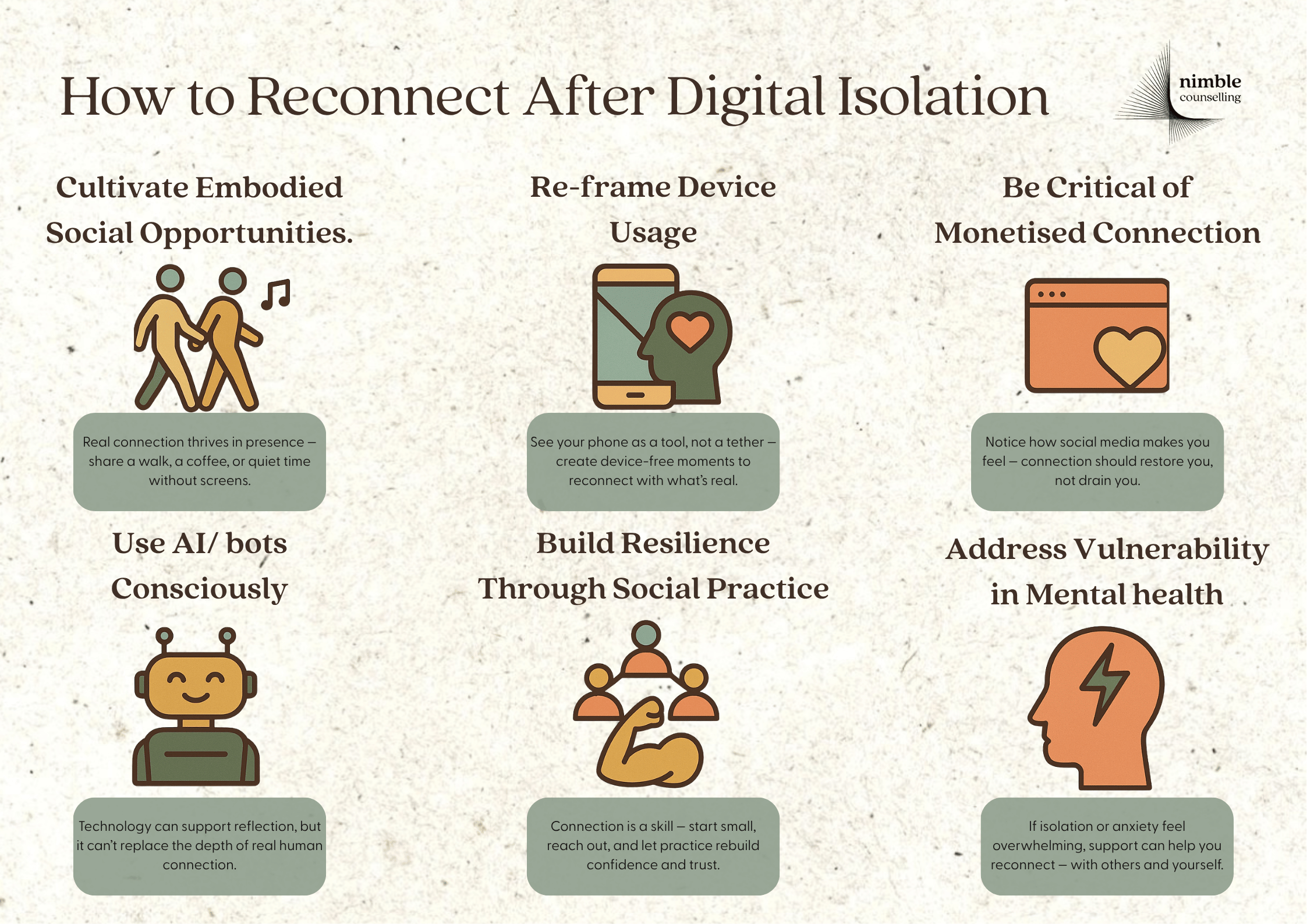Towards a Path of Meaningful Connection in the Digital Age (Social Isolation in the Age of Information)
In a world that increasingly prizes individualism, social connection has become both more necessary and, paradoxically, harder to sustain. In this series, Vancouver-based counsellor Alex Henderson explores how video games, social media, and artificial intelligence have reshaped the way we connect—and what happens when those digital spaces begin to replace real human contact. Drawing from insights in psychology and mental health practice, Alex examines the growing tension between digital convenience and genuine connection, and how this tension impacts our well-being. Each piece invites readers to reflect on the challenges of social isolation in the digital age and to consider how we might begin the slow, intentional work of reconnecting—with ourselves, with others, and with the world beyond our screens.
In this final piece, Alex explores what it means to rebuild connection when it starts to waver, and how we can take small, meaningful steps toward a more grounded and present way of being.
Read the other articles in this series here.
Learn more about this articles author Alex Henderson or book a free consult
If we accept that this problem is multi-layered- cultural, technological, psychological- then the solutions likewise must span levels.
Cultivate embodied social opportunities. Real connection doesn’t require grand gestures- it can be a shared walk, a café chat, a phone call with video turned off, a meeting without screens. The key is presence. Set aside time for interaction that is not mediated by algorithmic reward. Accept that silence, pause and even awkwardness are part of the human texture.
Re-frame device usage. Rather than seeing our phones and devices as social portals, see them as tools. Become aware of why you pick up your device: is it for genuine connection or for distraction? The CAMH article “Give me a break… from social media” describes an experiment where stepping away from apps led to more meaningful family conversations and a stronger sense of presence. Consider device-free times or zones (meals, walks, bed).
Be critical of monetised connection. Recognise that many platforms are designed for engagement, not necessarily for human flourishing. Ask: Do I feel connected after using this app, or do I feel drained, lonely, anxious? Research (e.g., by CAMH and others) shows that heavy social-media use correlates with poorer mental health outcomes. Use AI/ bots consciously. If you find solace in chatbots, acknowledge what they give and what they don’t. AI can supplement human interaction- but shouldn’t replace the unpredictable, messy richness of human connection. Be mindful if you begin choosing bots instead of people because people feel too hard.
Build resilience through social practice. Like any skill, social connection grows with practice. If you feel rusty, try small steps: invite someone you know for a short chat, join a local group, volunteer. Small social acts build capacity, trust, confidence.
Address vulnerability in mental health. If you’re struggling with social anxiety, depression or withdrawal, you might be using devices and bots as avoidance strategies. Given that poor connection and social isolation are themselves risk factors for worsening mental health, it’s important to consider support- whether professional or peer-based. CAMH’s research emphasises that mental health problems can intertwine with social media and device use.
Final Thoughts
In our age of individualism, attention wars, algorithmic mediation and even artificial companionship, the simple act of being with another person- in the flesh, unmediated, unreliable- is not trivial. It’s counter-cultural in a way. But it’s also deeply human.
Social isolation isn’t about being physically alone; it’s about being disconnected from the messy, nonlinear, improbable reality of real people. It’s about being out of practice in the give-and-take of presence. And as technology accelerates and mediates our social lives more and more, the risk isn’t only that we become lonely- it’s that we lose the habit of connection.
In some ways, all of this happens in the peripheral, when we become inattentive and our minds wander, so does our attention, and with it goes our presence. It is important to learn to take an active stance in one’s life, to learn to relish choice through the most appropriate means necessary and to see oneself as an agent in their own life, rather than a passive audience member. Even if we are not seeing ourselves this way, there are companies and computers that are and they are finding ways to harvest our labour and some of our worth as members of society.
The good news? The human heart still knows how to reach. Some of the most profound interactions don’t need perfect conditions- just a willingness to show up, risk a pause, lean into awkwardness, listen.
As we navigate the mediated, device-shaped world we inhabit, let’s remember: our devices can be servants; they shouldn’t become our social governors. Our connection to others isn’t just a polish or a filter- it’s the raw, unpredictable, vulnerable, irreplaceable stuff of life.
If you’re reading this, consider: when was the last time I sat with someone and didn’t check my phone? When was the last time I invited someone to talk and listened without distraction? And when was the last time I did something social just because, not because I could post about it?
Because maybe social connection doesn’t need to be optimized, or commodified, or mediated. Maybe it just needs to be lived.
If you or someone you know is struggling to find balance or connection, counselling can help. It offers a space to slow down, reflect, and rebuild the skills that support meaningful relationships — with technology, with others, and with yourself. At Nimble Counselling, we offer in-person sessions in downtown Vancouver and online counselling across BC, providing accessible support to help you reconnect in ways that feel authentic and lasting.
References
Centre for Addiction and Mental Health. Give me a break… from social media. https://www.camh.ca/en/camh-news-and-stories/give-me-a-break-from-social-media CAMH
Centre for Addiction and Mental Health. Youth, Smartphones and Social Media Use. https://kmb.camh.ca/ggtu/knowledge-translation/youth-smartphones-and-social-media-use Knowledge Mobilization at CAMH
Centre for Addiction and Mental Health. Social Media Use and Mental Health Among Students in Ontario. https://www.camh.ca/-/media/files/pdfs---ebulletin/ebulletin-19-n2-socialmedia-mentalhealth-2017osduhs-pdf.pdf CAMH
Verywell Mind. “The Social Media and Mental Health Connection.” https://www.verywellmind.com/link-between-social-media-and-mental-health-5089347 Verywell Mind



